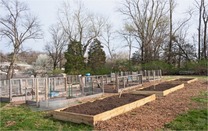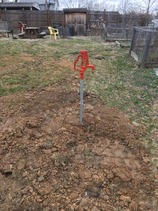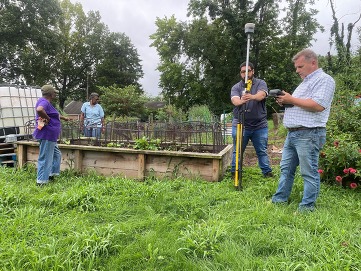|
USDA Food Loss and Waste Event
April 1 – 11AM to 12PM – Zoom Meeting
Please join Dr. Jean Buzby (USDA Food Loss and Waste Liaison) and a panel of leaders across USDA (OCE, NIFA, OUAIP, and FNS) to learn about some of the ways the USDA engages in food loss and waste prevention and reduction across the U.S. food supply chain. Register HERE.
Federal Advisory Committee for Urban Ag and Innovative Production
April 10 – 1 PM to 3PM – Zoom Meeting
Urban producers, innovative producers, and other stakeholders are invited to attend the virtual public meeting of the Federal Advisory Committee for Urban Agriculture and Innovative Production. Learn how to submit comments, see the agenda, and register HERE.
Grant Opportunities
Urban Farm Investment Tax Credit Program
The Missouri Agricultural and Small Business Development Authority's new program will issue Missouri tax credits based on eligible expenses incurred in the establishment or improvement of an urban farm which focuses solely on food production for sale or donation to the public. Learn more HERE.
Connect with St. Louis Growers
Sign up for STLGrowers listserv and connect with Saint Louis area producers to share questions and network: http://muext.us/STLGrowers.

The First Baptist Church of Webster Groves in St. Louis County founded the House of the Living Stone Community Garden in 2011 with the goal of creating flower beds for summer youth activities. As time went on, one small bed of summer flowers transformed into 22 raised gardening beds.
Today, church members and neighbors reserve the beds and have full autonomy for how to operate their space and what to grow. In the surrounding green space, there is an orchard and a shady gathering place. The House of the Living Stone Garden truly exemplifies what “community” means, providing a space for people to share ideas, gardening tools, and quality time as they grow food and flowers, and practice land stewardship.
This spring, the garden is welcoming more than just the daffodils, asparagus, and honeybees. For as long as there have been garden beds, gardeners have had to haul hoses up a hill to water their beds. However, over the last couple months, a new water line and hose spigots were installed, making work at the garden much easier.
|

House of the Living Stone Garden, Coordinator and Spokesperson, Florida Cargill explains, “We worked with our local Natural Resource Conservation Service Center office staff, who explained how we could utilize the Environmental Quality Incentive Program (EQIP) to apply for cost-share benefits.” Through EQIP the gardening program received technical and financial assistance for the planning and installation of the new water line. As the summer season approaches, Florida emphasizes how much help it will be to have a convenient, dedicated water source.
EQIP is designed to help producers address their resource concerns through technical and financial assistance. To learn about EQIP practices that can benefit your operation, reach out to the St. Louis Urban USDA Service Center to schedule a farm visit and get a USDA farm number. Here’s the team:
|
 |
FY24 Funding Opportunity
As a part of the St. Louis Urban Hub Initiative, NRCS in Missouri will accept applications in the Urban Hub in the ACT NOW format for the Enivronmental Quality Incentive Program (EQIP). Applications can be submitted at any time for the FY2024 and at this time a cut off has not been determined.
Based on fund availability, eligible applications that meet a minimum threshold score of 30 will be preapproved immediately, allowing the applicant to ACT NOW. Application assessments below the minimum threshold will be batched and funded in ranking order as funding allows.
The St. Louis Urban Hub Initiative is focused on assisting urban and small farmers within the St. Louis Urban Hub geographical area address resource concerns on their operations. Urban and small-scale farmers provide critical access to healthy food for local communities, as well as jobs, increased green spaces, and closer community ties.
For a map of the area covered by this initiative please click HERE.
Additional practices for the 2024 program year are now available including Rain Gardens, Safety Fence, and Small-Scale Farm Access Control.
For more information about these practices and their applicability to your operation please contact Sarah Szachnieski, NRCS Urban Conservationist, at 636.295.0138 or sarah.szachnieski@usda.gov, or E'lisa Moss, NRCS Urban Soil Conservationist, at 314.399.0629 or e'lisa.moss@usda.gov.
Finding the “right risk management fit” for your farm can feel overwhelming, especially for specialty and small-scale farmers and ranchers. That’s why U.S. Department of Agriculture’s Risk Management Agency (RMA) created a new resource for specialty and small-scale producers. A searchable database of crop insurance agents who sell Whole-Farm Revenue Protection and Micro Farm policies, two of the most comprehensive risk management options.
“This new tool is part of RMA’s broader efforts to make crop insurance more equitable and accessible for all producers,” said RMA Administrator Marcia Bunger. “Whole-Farm Revenue Protection and Micro farm are two of the most comprehensive risk management plans available, and they are especially important to specialty crop, organic, urban, and direct-market producers.”
Learn more HERE.
The U.S. Department of Agriculture (USDA) announced today that most farm loan borrowers will soon be able to make payments to their direct loans online through the Pay My Loan feature on farmers.gov in early February. Pay My Loan is part of a broader effort by USDA’s Farm Service Agency (FSA) to streamline its processes, especially for producers who may have limited time during the planting or harvest seasons to visit a local FSA office; modernize and improve customer service; provide additional customer self-service tools; and expand credit access to assist more producers.
On average, local USDA Service Centers process more than 225,000 farm loan payments each year. Pay My Loan gives most borrowers an online repayment option and relieves them from needing to call, mail, or visit a Service Center to pay their loan installment. Farm loan payments can now be made at the borrower’s convenience, on their schedule and outside of FSA office hours.
Pay My Loan also provides time savings for FSA’s farm loan employees by minimizing manual payment processing activities. This new service for producers means that farm loan employees will have more time to focus on reviewing and processing new loans or servicing requests.
The Pay My Loan feature can be accessed at farmers.gov/loans. To use the payment feature, producers must establish a USDA customer account and a USDA Level 2 eAuthentication (“eAuth”) account or a Login.gov account. This initial release only allows individuals with loans to make online payments. For now, borrowers with jointly payable checks will need to continue to make loan payments through their local office.
FSA has a significant initiative underway to streamline and automate the Farm Loan Program customer-facing business process. For the over 26,000 producers who submit a direct loan application annually, FSA has made various improvements including:
- The Online Loan Application, an interactive, guided application that is paperless and provides helpful features including an electronic signature option, the ability to attach supporting documents such as tax returns, complete a balance sheet, and build a farm operating plan.
- The Loan Assistance Tool that provides customers with an interactive online, step-by-step guide to identifying the direct loan products that may be a fit for their business needs and to understanding the application process.
- A simplified direct loan paper application, which reduced loan applications by more than half, from 29 pages to 13 pages.
The term “sodbusting” is used to identify the conversion of land from native vegetation to commodity crop production after December 23, 1985. As part of the conservation provisions of the Food Security Act of 1985, if you’re proposing to produce agricultural commodities (crops that require annual tillage including one pass planting operations and sugar cane) on land that has been determined highly erodible and that has no crop history prior to December 23, 1985, that land must be farmed in accordance with a conservation plan or system that ensures no substantial increase in soil erosion.
Eligibility for many USDA programs requires compliance with a conservation plan or system on highly erodible land (HEL) used for the production of agricultural commodities. This includes Farm Service Agency (FSA) loan, disaster assistance, safety net, price support, and conservation programs; Natural Resources Conservation Service (NRCS) conservation programs; and Risk Management Agency (RMA) Federal crop insurance.
Before you clear or prepare areas not presently under production for crops that require annual tillage, you are required to file Form AD-1026 “Highly Erodible Land Conservation and Wetland Conservation Certification,” with FSA indicating the area to be brought into production. The notification will be referred to NRCS to determine if the field is considered highly erodible land. If the field is considered HEL, you are required to implement a conservation plan or system that limits the erosion to the tolerable soil loss (T) for the predominant HEL soil on those fields.
In addition, prior to removing trees or conducting any other land manipulations that may affect wetlands, remember to update form AD-1026, to ensure you remain in compliance with the wetland conservation provisions.
Prior to purchasing or renting new cropland acres, it is recommended that you check with your local USDA Service Center to ensure your activities will be in compliance with the highly erodible land and wetland conservation provisions.
For additional information on highly erodible land conservation and wetland conservation compliance, contact your local USDA Service Center.
|